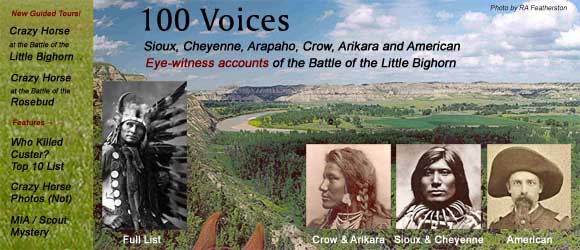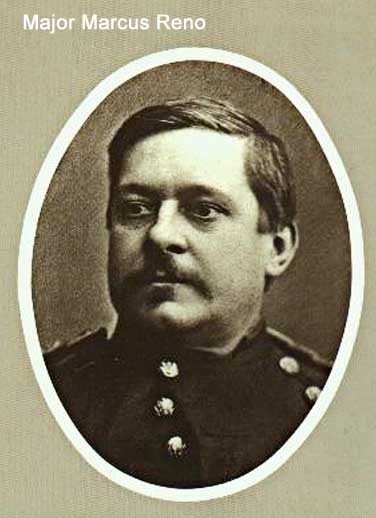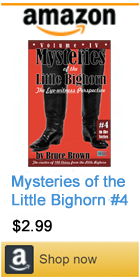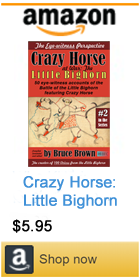|
|||||||
Bruce Brown's 100 Voices... Marcus Reno's Story of the Battle
I was given the command of Companies M, A and G, and was ordered [by Gen. Custer] to proceed at as rapid a gait as I thought prudent and afterward to charge, and that I would be supported by the whole outfit. This order was brought to me by Colonel Cooke, adjutant of the regiment. I never saw Custer again living, and the instructions embodied in these words were received from him. After Colonel Cooke gave me these instructions he rode with me for some time, as also Captain Keogh, and said, in his laughing, smiling, way, "We are all going with the advance and Miles Keogh is coming too." [Note: Here is William Slaper's description of this same moment; after this, Slaper recalled, "things began to liven up."] My attention was then taken up with the ford which I was to cross with the companies, and I never saw either alive again. After crossing the ford I sent word to Custer that the Indians were in front and very strong, but charged on down, supposing that I was being followed by him. As I neared the village I saw Indians passing from the hill behind my left flank. I knew no support could be coming, so I dismounted and took possession of a point of woods about a half mile upstream from the village, sheltered my horses and advanced to the attack, reaching within 200 yards of the village. The Indians then came out in overwhelming numbers, and it was plain to me that the salvation of my command depended on reaching a defensive position, which was accomplished by charging through the Indians to the bluffs, where I was joined by the other companies commanded by Colonel Benteen and Captain McDougall. The ford we crossed in getting to the bluff was not the same we had passed in going to attack the village. It was in front of the bluff, and it was partially by accident that we found it. When I went into action I had only 112 men and officers of the Seventh with me and some twenty-five scouts. If I had not made the charge for the bluffs my command would undoubtedly have been annihilated as Custer's was. The great mistake in the beginning was that we underestimated the Indian strength. The lowest computation puts the Indian strength at about 2,500, and some think there were 5,000 warriors present. The Indians are the best light cavalry in the world. I have seen pretty nearly all of them, and I do not except even the Cossacks. [Note: Capt. Anson Mills agreed, calling the Sioux and Cheyenne "the best cavalry soldiers on earth" after being whipped by Crazy Horse at the Battle of the Rosebud. For more info, see Indian Battlefield Tactics.] Among the gallant deeds in the Custer fight the splendid conduct of Lieutenant Cooke deserves special mention. He was the last officer to fall, and he remained mounted to the last after Custer's death. The command of the survivors fell on him, and with his small band he repeatedly charged the Indians. The Crow scout [this was Curley], who was the only known survivor, says that the Sioux warriors scattered time and time again before the desperate onslaught of Cooke and his handful of men, who fell at last, overwhelmed by innumerable enemies." [Note here is Wooden Leg's account of scalping Cooke's distinctive muttonchop whiskers.] The Custer Myth: A Source Book of Custerania, written and compiled by Colonel W.A. Graham, The Stackpole Co., Harrisburg, PA 1953, p 228 - 229
Major Marcus Reno commanded one of Custer's three wings, and led the attack on the giant Indian village on the Little Bighorn on June 25, 1876. This account of the battle was written six weeks later, and published in the New York Herald on August 8, 1876. Reno survived the Battle of the Little Bighorn, but actually the real battle for him didn't begin until the shooting was over. Custer's friends made Reno the scapegoat for Custer's debacle and forced him to spend the rest of his life fighting to clear his name. As the Custer clique saw it, Reno (who charged into the huge Indian village) was somehow a coward, and Custer (who hung back and never provided Reno the support he promised) was somehow a brave heart. Custer apologists saw Reno (who managed to save a portion of his men) as incompetent, and Custer (who divided his troops and then lost his entire command) as a military paragon. These arguments still echo faintly in the 21st century, but today no one seriously suggests that the responsibility for the American defeat at the Little Bighorn rests with anyone but George A. Custer. He must take the blame, and to try to shift it off on Reno as Custer loyalists like Seventh Cavalry survivor John Burkman does, merely diminishes Custer more. The truth is that on June 25, 1876, Custer and the U.S. Army's Seventh Cavalry (a mercinary force largely made up of recent immigrants and the sort of disadvantaged individuals who have long populated America's volunteer armies) met a combined Sioux / Cheyenne army under Sitting Bull, Crazy Horse, Gall, Crow King, Rain In The Face, Lame White Man, Two Moon and others that was superior in every way -- superior leadership, superior numbers, superior corps motivation, superior individual soldiers, superior horses and quite frankly, a superior cause. The Sioux were fighting to protect their families and their rightful homeland, while Custer's soldiers were an illegal invader force whose very presence on the landscape violated the Treaty of 1868, as does the continued presence of American invaders in the territory of the Sioux Nation today. Furthermore, the charges against Reno (cowardice, drunkeness, etc.) were all aired at his subsequent Court of Inquiry, and he was found innocent on all counts, although that didn't undo the damage Custer's friends did to him and his reputation, or stop their attacks on him. As late as 1934, John Burkman branded Reno a "coward," but others like William Slaper painted a different picture. Slaper recalled how "I observed Reno several times during the fighting on the bluffs, and can well remember his walking about among the men through the night... I know it encouraged his fellow-officers as well as the troopers." Perhaps the highest praise for Reno came from the Sioux. Even though Reno's men murdered Sioux women and children on Reno's initial charge at the Little Bighorn, Two Kettle Sioux war chief Runs The Enemy praised Reno's bravery, saying, "he only had a few soldiers and our camp was a great camp, and he came rushing into the camp with his few soldiers. In all the history of my great-grandfathers I have never known of such an attack in daylight." For a somewhat candid glimpse of what Reno thought of Custer's performance at the Little Bighorn, see the conversation John Burkman overheard on the night of June 26, 1876 during the Seige of the Greasy Grass. Nor was Reno alone in his scathing estimation of George A. Custer at the Battle of the Little Bighorn. According to Dr. H.R. Porter, who survived the Seige of the Greasy Grass with Reno, "during the two days we were surrounded by the Indians the inquiry among our men for Custer was loud, and that General's court-martial was freely speculated upon." -- Bruce Brown
|
|||||||




 "[AFTER RECEIVING orders from
"[AFTER RECEIVING orders from 









